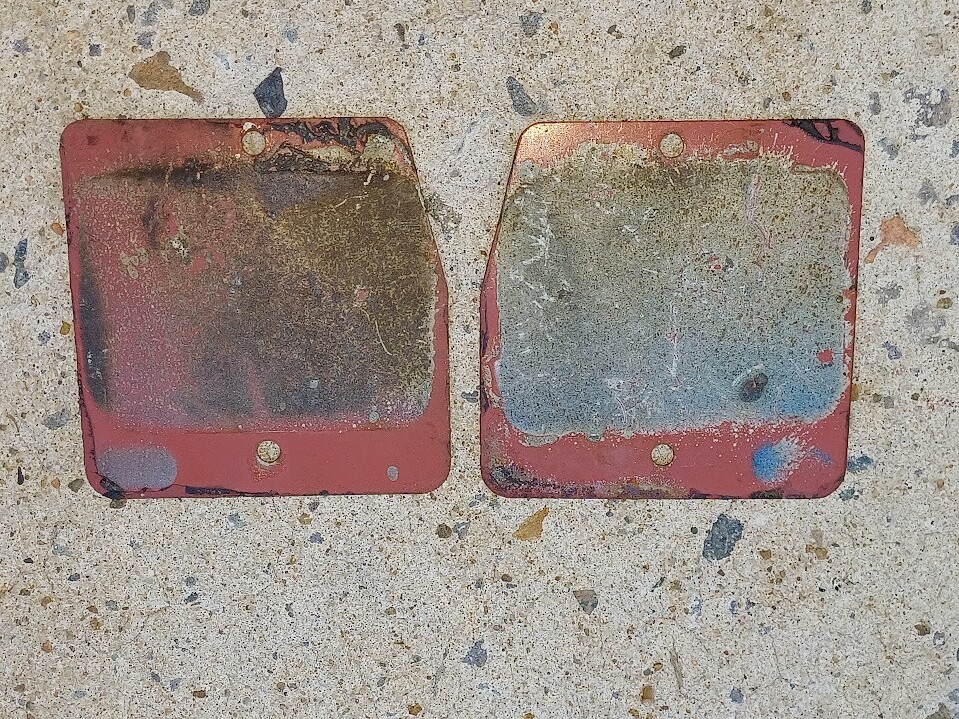1
Tires, Brakes & Suspension / Re: 1981 Rear Disc Brake Parking Brake
« Last post by roadking77 on Today at 01:10:44 PM »Ok. This is stupid. I spent about 6 weeks fiddling with the stupid parking brake. Spoiler Alert...It still aint right.
But all the parts are together and they should pass the PA State inspection.
Anyway, I figured I'd close the loop on this thread.
I finally found a picture of an actual marked, LH Caliper:GM Left Rear caliper by Tom Sherer, on Flickr
I am having a hard time figureing out my rear brakes!! I have hard lines on the axle to the caliper, BUT in the pics shown it looks like instead of a banjo bolt there is some kind of banjo bolt with a square block with threads to accept the hard brake line? Is this a special part/fitting and where can I find one.
As I suspected, the unmarked caliper on my left rear is wrong. You can see in the pic above how the park brake lever is up around 1 O'clock vs. 7 O'clock on the unmarked caliper I got when I ordered Ames PN FR218EB (now discontinued).Untitled by Tom Sherer, on Flickr
The orientation of the lever is determined by a metal 'stop' on the back side of the caliper + the hole that mounts the spring retainer.
Reviewing old GM Parts catalog info, combined with some notes I think came from a pre-crash TAC post from someone more familiar with these parts, I found the GM PN's for these calipers are:
18006748 Caliper Rear(LH)
18006749 Caliper Rear(RH)
And, These calipers were also used on Cadillac Seville's and El Dorado's of the era.
So, to have a properly installed and fully functional e-brake, I need to replace my LH caliper with the correct one.
Finally, I wanted to try to write something about adjusting the parking brake. 'Cause the instructions and video's I found seemed contradictory in some places. Maybe its just how my brain works. Here's how I'd describe the adjustment process:
Caliper is on the car. Pads installed.
When turning the post/actuator via the inner hex shape, the post will move in and out. There is some sort of ratcheting/clutch voodoo going on inside there. While the post can push on the piston, it is not directly connected to it.
Because of the way the post moves in and out, you need to install the lever retaining nut onto the post while turning it with an open-end wrench. The nut prevents the post from pulling too far in so you can't reach the inner hex shape...Like my first problem in this post.Untitled by Tom Sherer, on Flickr
Turning the post clock-wise pushes the piston outward, clamping the pads to the rotor / actuating the brake. Keep turning Clock-wise and eventually, the piston will clamp the pads on the rotor. It'll get tight and wont turn Clockwise anymore.
Turning the post counter Clockwise backs the post off the piston. but, remember it's not connected. So...it doesn't actually pull the piston back in. Turning Counter clock-wise works the adjustment mechanism. Because of magical, self-adjusting clutch/ratchet in there, a person could spin and spin and spin Clockwise and not notice any change. But, there's some sort of ratchet that is the key to adjusting the park brake actuator/lever.
OK, so...With the nut installed on the post, put a wrench on the inner 9/16 Hex and turn clock-wise until it wont turn anymore.
Here comes the 'trick'. The lever needs to fit onto that inner hex shape in a position that leaves no more than 1/8" gap between the lever and the stop on the caliper. Tighten down clock wise, then turn the post counter clock-wise. Just a 1/4 turn or so. You will feel the post try to pull in (but it can't 'cause you have the nut on there) you'll feel some resistance..push past it. That's the magical adjuster doing its job. Now...turn back CLOCKWISE. You should notice that your wrench doesn't return quite as far as where you started at before you feel it back to that tight position.
Repeat this...Turn to tight...Turn 1/4 counter clock-wise...then back to tight.
This ratcheting action moves the inner hex around. Repeat until is it clocked at the EXACT point where the lever will fit on with no more than 1/8" movement off the stop before it feels tight.
Good Luck!
-Tom


 Recent Posts
Recent Posts



